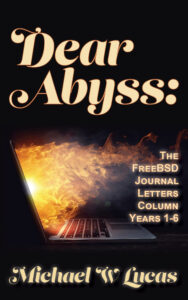TLDR: “Networking for Systems Administrators, 2nd Edition” is open for sponsorships at https://www.tiltedwindmillpress.com/product/n4sa2e-sponsor/ and I would appreciate your support.
Longer version:
Every large company I’d ever worked in since 1995 suffered from a continuous feud between the sysadmins and the network team. One team would demand an inch, the other would insist on 25.4 millimeters, and battle was declared. As someone with an ankle shackled in each world, I quickly reached two conclusions.
One, the job is hard enough without us arguing past each other.
Two, everybody involved needed a short sharp visit from the Slap Fairy.
About ten years ago I achieved my lifelong goal of becoming a full-time writer, and promptly lost my mind. I could keep being a writer so long as I kept bringing in money. If I didn’t bring in money, I’d get stuffed back in a cubicle. I had to write books, and quickly. I had made a list of titles I could spew fast. One of them was “Networking for Systems Administrators,” meant to end that feud or at least bring about a ceasefire.
Because my other goal was “pay the mortgage before I get stuffed back into a cubicle,” I slammed out that manuscript in about a month.
To my surprise, it was well-received. Managers bought the book in bulk to distribute to their staff. Network administrators bought it to give to select colleagues. Sysadmins bought so they could successfully argue with their network administrators.
It’s been ten years, and that book needs updating. Some of the commands have been changed. 100Mb Ethernet is rare, while 10G and 100G are almost common. There’s all those tidbits I could have done better, if I hadn’t been driving myself too hard. Let’s Encrypt made TLS omnipresent, so I need to add that. And of course it must have a proper Eddie Sharam cover.
If I get ~100 print sponsors I’ll do another challenge coin, like the one I did for Run Your Own Mail Server (https://mwl.io/archives/23836).
So, yeah. https://www.tiltedwindmillpress.com/product/n4sa2e-sponsor/ is my effort to bring a tiny peace to IT departments around the world. I would be grateful for your sponsorship, and your support with the mortgage part.
Thank you for your consideration.
PS: I should also mention that my collected FreeBSD Journal advice columns, Dear Abyss, is going to kickstarter soon. “Dear Abby for Sysadmins” isn’t going to sponsorship, but if you’re interested you might check it out. (https://mwl.io/ks)


